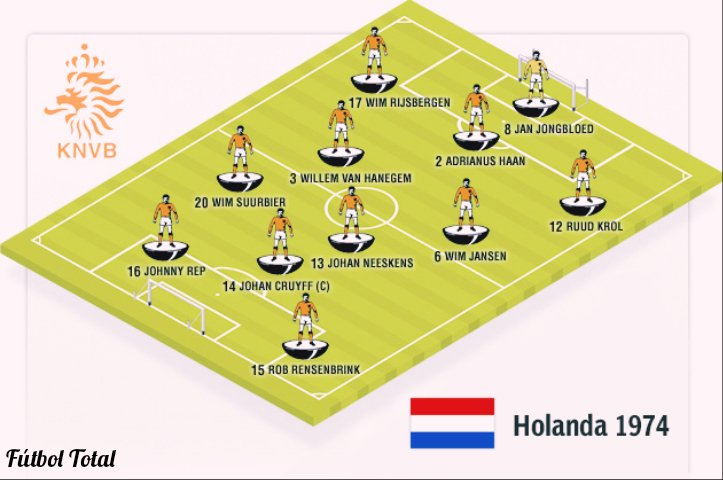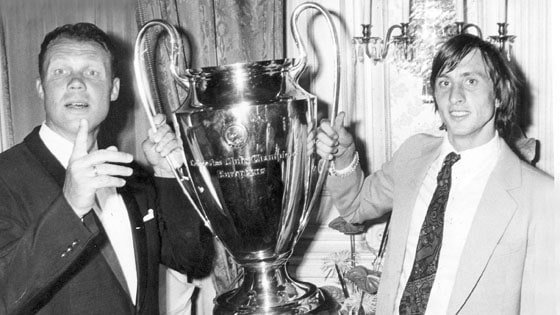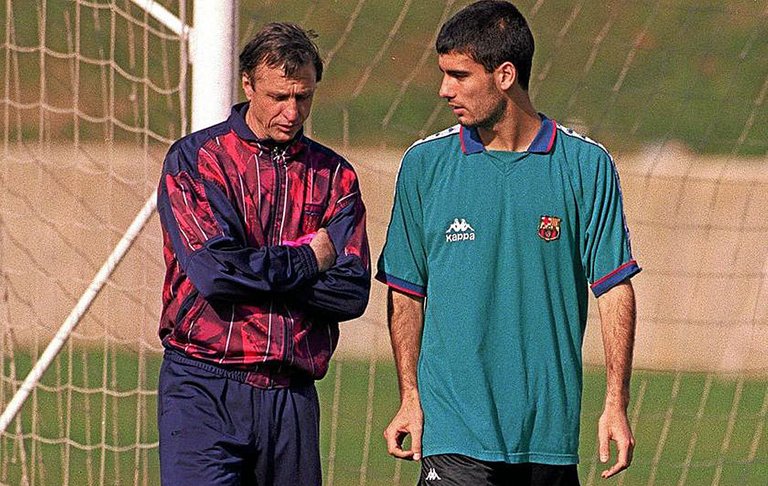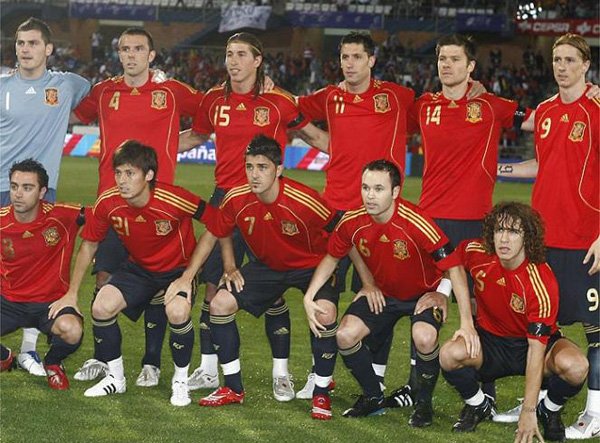Un cordial saludos a los amantes del futbol y deportes en general, en este artículo le daré un seguimiento a lo que titule estilos de juego, una serie de post donde expongo como el futbol no solo trata de correr hacia la portería contraria y marcar gol, sino que va más allá de eso y en general tiene distintas cualidades y características como evolución, trascendencia, iniciativa, eficacia, así como las distintas formas que contribuyeron a esto como son los propios partícipes entre equipo y cuerpo técnico, en este post señalo como nacio en algun momento el "Futbol Total" un sistema que sirvio de inspiracion para que posteriormentre surgiera el "futbol Tiki-Taka", aquel que ha sido reconocido por ser tanto el Barcelona como la seleccion de España los que han desarrollado ese sistema.
A cordial greeting to the lovers of soccer and sports in general, in this article I will give a follow up to what I title styles of game, a series of post where I expose as the soccer not only tries to run towards the opposite goal and to score goal, but that goes beyond that and in general it has different qualities and characteristics as evolution, transcendence, initiative, effectiveness, As well as the different forms that contributed to this as they are the own participants between equipment and technical body, in this post I indicate as it was born in some moment the "Total Soccer" a system that served of inspiration so that later arose the "soccer Tiki-Taka", that has been recognized by being so much Barcelona as the selection of Spain those that have developed that system.
El tiquitaca en teoría es la evolución del Futbol Total Holandés de la década 70 y 80, que a su vez es la herencia del estilo de juego de la selección de Hungría que desarrollo en los años 50 donde alcanzaron la final en Suiza 1954, el tiquitaca moderno es un estilo de juego caracterizado por mantener durante gran tiempo del partido la posesión del balón, constantemente buscando el movimiento del mismo así como espacios donde pueda haber transiciones de pases cortos y precisos, este estilo depende de gran medida de las capacidades físicas en el medio campo, los jugadores deben ser capaces de rotar el balón de un lado a otro con toques limpios y precisos, además en gran medida optar por correr y aplicar el desmarque para poder recibir el balón en zonas libre de marca, para que así las transiciones sean más efectiva.
Tiquitaca in theory is the evolution of the Dutch Total Football of the 70s and 80s, which in turn is the heritage of the style of play of the Hungarian national team that developed in the 50s where they reached the final in Switzerland 1954, the modern tiquitaca is a style of play characterized by maintaining possession of the ball for a long time during the game, Constantly looking for the movement of the same as well as spaces where there can be transitions of short and precise passes, this style depends largely on the physical capabilities in the midfield, players must be able to rotate the ball from one side to another with clean and precise touches, also largely choose to run and apply the offside to receive the ball in areas free of mark, so that transitions are more effective.
 source
sourceEl origen de este estilo como se menciona es la evolución del “Futbol Total” neerlandés; un sistema donde cada jugador del equipo cuando se moviera de su posición habitual era sustituido en esa posición por otro compañero conservando la estructura táctica, eran rotaciones internas de jugadores intercambiando posiciones a excepción del portero donde ningún jugador tenía un papel asignado, lo que conllevaba que aquel jugador que comenzó siendo defensa en algún tramo del partido era delantero, y lo mismo pasaba con el delantero que después era defensa.
The origin of this style as mentioned is the evolution of the Dutch "total soccer"; a system where each player of the team when moving from his usual position was substituted in that position by another teammate conserving the tactical structure, they were internal rotations of players interchanging positions except for the goalkeeper where no player had an assigned role, which implied that that player who started as a defender in some part of the game was a forward, and the same thing happened with the forward who later became a defender.
 source
sourceEste estilo lo perfecciono Rinus Michels cuando dirigió al Ajax Ámsterdam donde tuvo mayor apogeo cuando contaba en sus filas con Johan Cruyff, tanto en el Ajax como en la Selección de Holanda, se señala que los orígenes del estilo en el club los implanto Jack Reynolds, cuando fue técnico a principios de mitad de siglo, al mismo tiempo es considerado la evolución y estilo heredero de la Selección de Hungría, más conocida como equipo de oro en la década de los 50, dirigida por Gusztav Sebes, quien gano la medalla de oro en los juegos olímpicos de Helsinki 1952 y subcampeona en el mundial Suiza 1954, contaba esa selección con otro jugador legendario como lo fue Ferenc Puskas, acompañado de Zoltan Czibor, Sandor Kocsis y Nandor Hidegkuti esta seleccion logro la hazaña de 30 partidos sin perder para su tiempo una gran hazaña.
En las propias palabras de Michels; él explica que las características del estilo consiste en “acosar” sin tregua ni respiro al rival para recuperar la posesión del balón sin ceder bajo ninguna circunstancia la iniciativa de ataque del mismo, todo dependiendo de una “excelente preparación física y un espíritu inquebrantable”, asi que en su propia palabras Michels, para su época aplico lo que se conoce hoy como Pressing, Presión Alta en español y la tactica del fuera de juego, todo era aplicado de forma sistemática y es bien sabido y como dice Rinus Michels para el éxito de la misma la preparación física es primordial y fundamental.
This style was perfected by Rinus Michels when he coached Ajax Amsterdam where he had his greatest success when he had Johan Cruyff in his ranks, both at Ajax and in the Dutch National Team. It is pointed out that the origins of the style in the club were implanted by Jack Reynolds, when he was coach at the beginning of half a century, at the same time it is considered the evolution and style inherited from the Hungarian National Team, better known as the gold team in the 50s, directed by Gusztav Sebes, who won the gold medal in the 1952 Helsinki Olympics and was runner-up in the 1954 Switzerland World Cup, this team had another legendary player as it was Ferenc Puskas, accompanied by Zoltan Czibor, Sandor Kocsis and Nandor Hidegkuti this selection achieved the feat of 30 games without losing for his time a great feat.
In Michels' own words; he explains that the characteristics of the style consist of "harassing" without respite or respite from the opponent to regain possession of the ball without giving up under any circumstances the initiative to attack, all depending on an "excellent physical preparation and an unbreakable spirit", so in his own words Michels, for his time applied what is known today as Pressing, High Pressure in Spanish and the offside tactic, everything was applied systematically and is well known and as Rinus Michels says for the success of the same physical preparation is paramount and fundamental
 source
sourceMichels and Cruyff lifting a European Cup won at Ajax
 sourceRinus Michels and Johan Cruyff in Netherlands
sourceRinus Michels and Johan Cruyff in NetherlandsEn teoría son tres aspectos lo que abarca este estilo; posesión casi total de la pelota, presión sobre el rival y una triangulación fluida de pases hasta llegar a la portería contraria, para ello depende de jugadores capacitados tanto técnicos, táctica y físicamente, por ello la adaptabilidad, la consciencia en cuanto a lo táctico, la velocidad y resistencia por las rotaciones que en su mayoría son fatigosas son las cualidades y virtudes futbolísticamente que ameritan cada jugador, pero hoy en día todo ha cambiado y estas rotaciones si bien se dan en varios partidos de clubes y selecciones que las optan, ya el futbol tiquitaca lo modernizo. Ahora este estilo de Futbol total dio como resultados y logros la gran recordada “Naranja Mecánica”, esa selección holandesa que gano la Eurocopa de 1988 y alcanzo dos finales consecutivas en 1974 y 1978, esa denominación fue una comparación entre el color de la indumentaria y la famosa película con el mismo nombre de Stanley Kubrick, de modo que hubiera un símil a un sobresaliente juego colectivo por los toques y las estrellas individuales que brillaban como lo fueron Johan Cruyff, Johan Neeskens, Johnny Rep, y más adelante Ronald Koeman, Ruud Gullit, Marco Van Basten, Frank Rijkaard entre otros. Digo esto porque esta Selección dejo un legado, es señalada por expertos como el Mejor equipo de la historia a pesar de no haber ganado nunca un mundial por su idea revolucionara de sacarle provecho a la cancha en toda su extensión de la mano de Johan Cruyff como director en el campo de juego
In theory there are three aspects to this style; Almost total possession of the ball, pressure on the opponent and a fluid triangulation of passes until reaching the opposite goal. For this, it depends on technically, tactically and physically capable players, which is why adaptability, awareness of the tactical, the speed and resistance by the rotations that in their majority are fatiguing are the qualities and virtues that deserve each player, but nowadays everything has changed and these rotations although they occur in several games of clubs and selections that opt them, already the soccer tiquitaca I modernize it. Now this style of total soccer gave as results and achievements the great remembered "Clockwork Orange", that Dutch selection that won the Eurocup of 1988 and reached two consecutive finals in 1974 and 1978, that denomination was a comparison between the color of the clothes and the famous movie with the same name of Stanley Kubrick, so that there would be a simile to an outstanding collective game because of the touches and individual stars that shone like Johan Cruyff, Johan Neeskens, Johnny Rep, and later Ronald Koeman, Ruud Gullit, Marco Van Basten, Frank Rijkaard among others. I say this because this National Team left a legacy, it is pointed out by experts as the best team in history in spite of never having won a World Cup because of its revolutionary idea of taking advantage of the field in all its extension by the hand of Johan Cruyff as a director in the field.
 sourceDutch selection in 1974, nicknamed "The Clockwork Orange"
sourceDutch selection in 1974, nicknamed "The Clockwork Orange"Ahora como dije el tiquitaca es la combinación de dos estilos el primero fue impuesto por el famoso “equipo de oro” húngaro, antes mencionado, ya que los jugadores de esa selección como Ferenc Puskas, Zoltan Czibor, Sandor Kocsis y Ladislao Kubala, llamados en su tiempo como “los magiares poderosos”, recalaron en equipos de la liga española, así incorporaron sus tácticas y capacidades técnicas al futbol español.Posteriormente esa semilla sembrada por los Húngaros comenzó a germinar y crecer cuando otro fiel seguidor del estilo como lo fue el ya mencionado Rinus Michels fue entrenador del Barça a principios de los años 1970, pero él, la mejoro con el ya aclarado “Futbol Total” que años después siguió aplicándose hasta explotar cuando de jugador paso a entrenador Johan Cruyff siguiendo el legado que desempeño junto a Michels en el Ajax con esto así quedo definida la filosofía imperante en el FC Barcelona, ya años más tarde Luis Aragones, Pep Guardiola, Vicente del Bosque entre otros perfeccionaron los métodos y así se quedó impregnada la esencia del juego en el FC Barcelona, la selección y clubes españoles, pero al mismo tiempo que todas estas filosofías futbolísticas basan su juego en el toque de balón y posesión como principal método en el momento de plantear un partido, difieren en diferentes aspectos, mayormente por las capacidades físicas de cada grupo de futbolistas y por la evolución del futbol de acuerdo a los años.
Now as I said the tiquitaca is the combination of two styles the first one was imposed by the famous Hungarian "golden team", before mentioned, since the players of that selection as Ferenc Puskas, Zoltan Czibor, Sandor Kocsis and Ladislao Kubala, called in their time as "the powerful magyars", arrived in teams of the Spanish league, this way they incorporated their tactics and technical capacities to the Spanish soccer. Later that seed sown by the Hungarians began to germinate and grow when another faithful follower of the style as it was the already mentioned Rinus Michels was the trainer of the Barça at the beginning of the years 1970, but he, improved it with the already clarified "Total soccer" that years later continued being applied until exploding when of player I happen to train Johan Cruyff following the legacy that I perform next to Michels in the Ajax with this way I am defined the prevailing philosophy in the FC Barcelona, years later Luis Aragones, Pep Guardiola, Vicente del Bosque among others perfected the methods and thus the essence of the game was impregnated in FC Barcelona, the Spanish national team and clubs, but at the same time that all these soccer philosophies base their play on the touch of the ball and possession as the main method at the time of setting up a match, they differ in different aspects, mostly because of the physical capacities of each group of footballers and the evolution of soccer according to the years.
 sourceJohan Cruyff and Pep Guardiola at FC Barcelona, Cruyff is said to have been Guardiola's mentor as was Rinus Michels with him.
sourceJohan Cruyff and Pep Guardiola at FC Barcelona, Cruyff is said to have been Guardiola's mentor as was Rinus Michels with him.La diferencia entre el “futbol total” y el llamado “tiki-taka” consiste en que el primero depende de la movilidad y libertad absoluta de sus futbolistas sobre el terreno de juego gracias al poderío físico, mientras que el segundo se basa en el dominio del balón así como las habilidades técnicas principalmente ocupando los espacios con las transiciones rápidas por medio del toque de balón eficazmente, generando mayor presión hacia los rivales cuando se defiende debido a que al momento de un jugador perder el balón se encuentra rodeado de compañeros “frescos” que abarcan el espacio y así el rival está sofocado y mayormente intenta un pelotazo si no tiene espacio para conducir.
The difference between "total soccer" and the so-called "tiki-taka" is that the former depends on the mobility and absolute freedom of its players on the field thanks to the physical power, while the latter is based on the mastery of the ball as well as the technical skills mainly occupying the spaces with the fast transitions through the touch of the ball effectively, generating more pressure towards the opponents when defending because at the moment a player loses the ball he finds himself surrounded by "fresh" teammates who take over the space and thus the opponent is suffocated and mostly tries a ball if he does not have space to drive.
 sourceSpain team, champion of Eurocup 2008
sourceSpain team, champion of Eurocup 2008En la actualidad desde que desapareció el Jogo Bonito o el Futbol Total, debido a los éxitos conseguidos por la selección española y el FC Barcelona los equipos que compiten en la liga española adoptan el sistema moderno de tiquitaca, asi como se ha expandido a ligas como la inglesa o alemana donde la acoplan a su estilo de juego.
Nowadays, since Jogo Bonito or Total Soccer disappeared, due to the successes achieved by the Spanish national team and FC Barcelona, the teams that compete in the Spanish league adopt the modern system of tiquitaca, as well as it has expanded to leagues like the English or German one where they adapt it to their style of play.
Congratulations @leedercastle! You have completed the following achievement on the Hive blockchain and have been rewarded with new badge(s) :
You can view your badges on your board and compare yourself to others in the Ranking
If you no longer want to receive notifications, reply to this comment with the word
STOP